Related Research Articles

The Pacific Electric Railway Company, nicknamed the Red Cars, was a privately owned mass transit system in Southern California consisting of electrically powered streetcars, interurban cars, and buses and was the largest electric railway system in the world in the 1920s. Organized around the city centers of Los Angeles and San Bernardino, it connected cities in Los Angeles County, Orange County, San Bernardino County and Riverside County.

The J.G. Brill Company manufactured streetcars, interurban coaches, motor buses, trolleybuses and railroad cars in the United States for almost ninety years, making it the longest-lasting trolley and interurban manufacturer. At its height, Brill was the largest manufacturer of streetcars and interurban cars in the US and produced more streetcars, interurbans and gas-electric cars than any other manufacturer, building more than 45,000 streetcars alone.

Old Pueblo Trolley is a non-profit, educational corporation based in Tucson, in the U.S. state of Arizona, that is dedicated to the preservation of Arizona's mass transit history. The name also commonly refers to the heritage streetcar line which OPT began operating in 1993, on which service is currently indefinitely suspended. OPT consists of three divisions that each fill a specific role in preserving the state's mass transit history. The divisions are the Street Railway Division, Motor Bus Division and the Museum Division.
Timeline of mass transit in Atlanta:
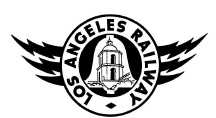
The Los Angeles Railway was a system of streetcars that operated in Central Los Angeles and surrounding neighborhoods between 1895 and 1963. The system provided frequent local services which complemented the Pacific Electric "Red Car" system's largely commuter-based interurban routes. The company carried many more passengers than the Red Cars, which served a larger and sparser area of Los Angeles.

Johnstown Traction Company (JTC) was a public transit system in Johnstown, Pennsylvania, United States. For most of its existence it was primarily a street-railway system, but in later years also operated rubber-tired vehicles. JTC operated trolley (tram) service in Johnstown from February 23, 1910 to June 11, 1960. Johnstown was one of the last small cities to abandon trolley service in the United States. It was also the smallest city to acquire a fleet of PCC cars and acquired trackless trolleys at a late date compared to larger transit properties. Many of the 1920s-era cars went directly to museums; however, none of the 17 PCC streetcars were saved. Efforts to sell the 16 then-surviving PCC cars intact were unsuccessful, and in 1962 they were scrapped, but many of their components were salvaged and sold to the Brussels, Belgium tram system, reused in the last series of single PCC trams (7156–7171), which ran from 1970 until February 2010.

The Glendale and Montrose Railway Company (G&M) was an interurban electrified railway in Southern California, in the United States. It was unique among the Los Angeles local railways, as it was among the area's only interurban line never absorbed into the expansive Pacific Electric system.
Pentrex Media Group, LLC, is an American producer and seller of railfan-related videos and DVDs. It was founded in 1984 and was originally headquartered in Pasadena, California.
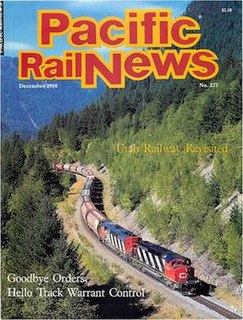
Pacific RailNews(PRN), originally named Pacific News and later RailNews, was an American monthly magazine about railroads and rail transit, oriented for railfans. It was published from 1961 until 1999. Although its coverage primarily concerned the western United States and western Canada, the magazine included less-detailed news on railroads and rail-transit from non-western states, as well as Mexico.

Passenger Train Journal(PTJ) is an American magazine about passenger rail transport and rail transit past and present, oriented for railfans and published currently by White River Productions. Founded in 1968, it was published continuously until 1996, and monthly from 1979 onward, but then ceased publication. After a 10-year absence, it was restarted in 2006 with a different publishing company, as a quarterly magazine. PTJ deals exclusively with passenger rail, not freight. Although focused on North America, each issue includes at least a small amount of content on overseas—usually European—passenger rail. The magazine is headquartered in Lee, Illinois.
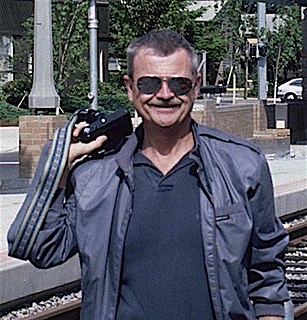
George McClelland Sebree III, better known as Mac Sebree, was an American journalist, writer and publisher whose area of expertise was urban mass transit, particularly urban rail transit. He was also a businessman, being owner and president of the publishing company, Interurban Press, from 1975 until 1993. In addition to writing and publishing historical material, he also followed – and regularly reported on – contemporary developments concerning rail transit, and by the 1990s he had become an expert on light rail in North America.

The New Electric Railway Journal was a quarterly American magazine primarily about electric urban rail transit in North America, published from 1988 to 1998, with an international circulation. Its name was a tribute to a much earlier magazine with similar coverage, the Electric Railway Journal, established in 1884 and published until 1931.
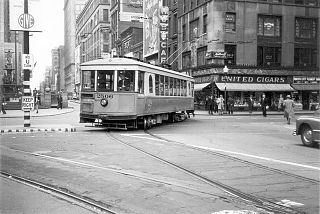
Streetcars operated by the Cincinnati Street Railway were the main form of public transportation in Cincinnati, Ohio, at the end of the 19th century and the start of the 20th century. The first electric streetcars began operation in 1889, and at its maximum, the streetcar system had 222 miles (357 km) of track and carried more than 100 million passengers per year. A very unusual feature of the system was that cars on some of its routes traveled via inclined railways to serve areas on hills near downtown. With the advent of inexpensive automobiles and improved roads, transit ridership declined in the 20th century and the streetcar system closed in 1951.
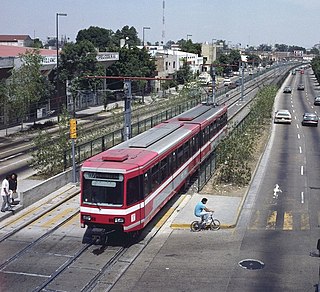
Bombardier Transportation México is a subsidiary company of Bombardier Transportation located in Ciudad Sahagún, Mexico.

The Los Angeles Pacific Railroad (1896−1911) (LAP) was an electric public transit and freight railway system in Los Angeles County, California. At its peak it had 230 miles (370 km) of track extending from Downtown Los Angeles to the Westside, Santa Monica, and the South Bay towns along Santa Monica Bay.

The Riverfront Streetcar Line is a historic streetcar line in New Orleans, Louisiana. It is operated by the New Orleans Regional Transit Authority (RTA). It was built along the east bank of the Mississippi River, in an area with many amenities catering to tourists. It opened August 14, 1988, making it the first new streetcar route in New Orleans in 62 years. The line runs 2 miles (3.2 km) from Julia Street at the upper end of the New Orleans Convention Center to the downriver (far) end of the French Quarter at the foot of Esplanade Avenue. Unlike the other three lines, it travels on an exclusive right-of-way, along the river levee beside New Orleans Belt Railway tracks, making it more akin to a light rail line. The line was regauged in 1997 from standard gauge to broad gauge. Officially, the Riverfront Line is designated Route 2 and is designated with a blue color on most RTA publications.

The Milwaukee & Suburban Transport Corporation, commonly known as the Transport Company, was a public transport company in Milwaukee, Wisconsin.
References
- 1 2 3 4 5 6 7 8 9 10 11 12 MacDougall, Kent (May 19, 1983). "Books Ring Bell With Devotees: Publisher Specializes in History of Trolleys". Los Angeles Times , p. 1.
- 1 2 3 4 5 6 Ryll, Thomas (November 29, 1994). "Felida man tracks light rail" (profile of retired Interurban Press owner Mac Sebree). The Columbian , p. A3.
- 1 2 3 4 5 6 7 Klein, Karen E. (April 26, 1992). "Flood Brings a Deluge of Book Orders". Los Angeles Times . Retrieved December 26, 2012.
- ↑ The terms "streetcar" and "trolley" are effectively synonyms in most parts of the United States, a fact noted in the following book: Veteran & Vintage Transit by Andrew D. Young (1997). ( ISBN 0-9647279-2-7). St. Louis: Archway Publishing.
- 1 2 3 4 Demoro, Harry W. Ira L. Swett The Electric Railway Historical Association of Southern California. Retrieved December 26, 2012.
- ↑ The First 100 Specials of Interurbans. The Electric Railway Historical Association of Southern California. Retrieved December 26, 2012.
- ↑ Rice, Walter; Echeverria, Emiliano. "San Francisco's 40-line: San Mateo Interurban Car—Minimum Fare 10¢". Virtual Museum of the City of San Francisco. Archived from the original on October 19, 2007. Retrieved December 26, 2012.
- ↑ Lester, David C., ed. (Winter 2007). "Passenger Train Journal Resumes Publication" (PDF). Railway & Locomotive Historical Society Newsletter. Vol. 27, no. 1. Sacramento, CA: Railway & Locomotive Historical Society. p. 12. Retrieved December 26, 2012.
- ↑ McKinney, Kevin. "On the Point". Passenger Train Journal , issue 229 (4th Quarter, 2006), p. 2. White River Productions. ISSN 0160-6913.
- ↑ Swanson, Carl (October 1993). "Pentrex Buys Interurban Press". Passenger Train Journal . Pentrex. p. 8. ISSN 0160-6913.